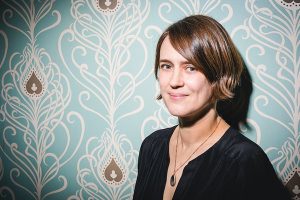Ingrid Laubrock: The Last Quiet Place
When saxophonist Ingrid Laubrock finds herself in her comfort zone, it is typically in small group formations—often just duos or trios—which allow her unparalleled skills as an improviser to shine most brightly. However, listeners are always in for a special treat when she ventures out into less familiar terrain, especially with larger ensembles. On recordings such as Contemporary Chaos Practices (Intakt, 2018) or Dreamt Twice, Twice Dreamt (Intakt, 2020), Laubrock takes advantage of the opportunity to develop her ambitious compositional vision by using a larger palette of instrumentalists, and the results are always stimulating and revealing. So it is a welcome occasion that her first leader date for Pyroclastic Records features a stellar sextet, including some of the finest musicians in the contemporary creative jazz scene.
Half of the group on The Last Quiet Place is made up of previous Laubrock collaborators: guitarist Brandon Seabrook, bassist Michael Formanek and drummer Tom Rainey, the last of whom has been Laubrock’s percussion partner for too many recordings to count. But they are joined here by violinist Mazz Swift and cellist Tomeka Reid—two-thirds of the string trio Hear in Now (along with bassist Silvia Bolognesi), whose Not Living in Fear (International Anthem) was one of the highlights of 2017. Swift and Reid are indispensable components of Laubrock’s concept, as they provide lyrical sensitivity in one moment, rhythmic counterpoint in the next, and rich texture in others, all of which allow Laubrock to produce some of her most entrancing compositions to date.
The album’s six substantial pieces are a mixture of moods and gestures. The elusive opening cut, “Anticipation,” makes brilliant use of Swift and Reid, who help establish the ebb and flow of a track which builds and subsides in intensity. Laubrock’s sinuous melodicism is noteworthy, and there is a subtle rhythmic energy that reveals itself during the last portion of the track. Seabrook, known for his aggressive instincts as a guitarist, is rather restrained here, providing a reflective surface for the other players, and sustaining the piece’s momentum with careful interjections and subtle commentary. “Grammy Season,” by contrast, surges from the outset, with a cantankerous Formanek ostinato which catalyzes the group’s energies, with Seabrook in a feistier disposition and Laubrock becoming more animated too, with the strings eventually joining in the collective fervor. The album’s title track offers another dimension of the group’s sound, and it features Laubrock at her most tuneful, with a gorgeous soprano solo which soars over the band’s steady churn.
The genius of Laubrock’s compositions lies in the way they balance compositional structure with improvisational freedom. These pieces are thoroughly designed but within their parameters lie abundant opportunities for the musicians to explore their potentialities. The emphatic, jagged dialogue which emerges between Seabrook and Reid on “Grammy Season” is one example; another is the rhythmically charged exchange between Laubrock and Rainey midway through “Afterglow,” punctuated by Seabrook’s occasional serrated bursts. One of the advantages of having a lockdown rhythm unit such as Formanek and Rainey is that it enables these micro-configurations to take shape seamlessly within the flow of each piece.
The album’s closing track, “Chant II,” revisits a piece first recorded by Laubrock and Rainey on one of their many duo albums, Utter (Relative Pitch, 2018). Here it is enhanced dramatically by the additional instrumentation, from the opening transfixing dialogue between Reid and Swift to an especially tenacious Seabrook solo, and finally finishing with a shared ostinato “chant” as the group once again finds a way to merge its individual voices into a compelling whole—the winning modus operandi of this excellent release.


